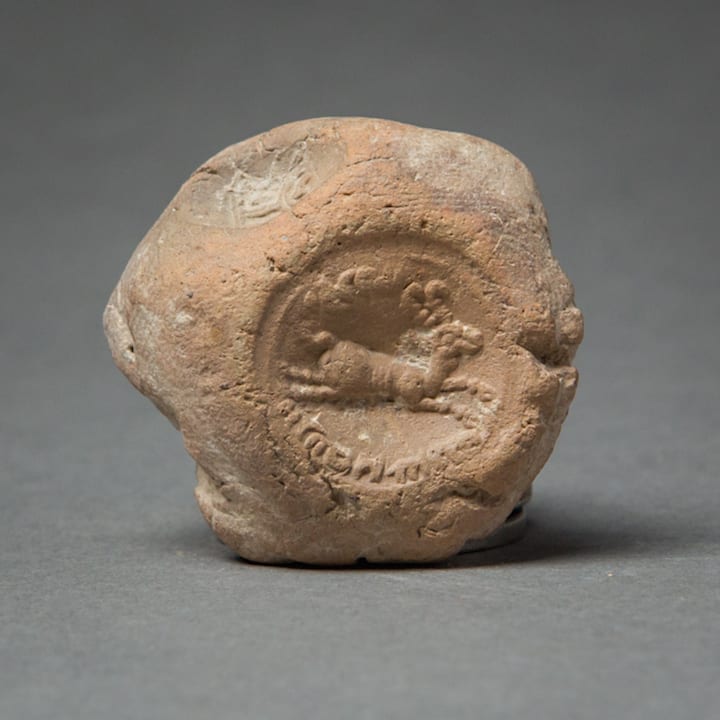Sassanian Bulla with Galloping Ram, 200 CE - 600 CE
Clay
height 3.2 cm
height 1 1/4 in
height 1 1/4 in
LO.1071
As the last great Iranian dynasty before the advent of Islam, the Sasanian dynasty (224-642 AD) is best remembered for its distinctive cultural expressions and the longevity of its rule....
As the last great Iranian dynasty before the advent of Islam, the Sasanian dynasty (224-642 AD) is best remembered for its distinctive cultural expressions and the longevity of its rule. With an immense territory stretching from Transcaucasia to the Indus valley, Sasanians engaged in intense trade and exchange, of which, sealstones and bullae are an interesting reflection. Bullae (from the latin Bulla-ae) are clay or bitumen impression of seals used as voucher that were usually attached to documents or – in fewer instances- parcels (or the strings used to bound them) and showed the identity of the author or witness of the document , or the owner of the merchandise. The middle Persian word for bulla, gil muhrag is known from an Iranian loanword in Aramaic Talmud, while a number of clay bullae from the Sasanian era have been discovered not only at various Sasanian sites including Takht-e Suleiman and qasr-e Abu Nasr but also in Transoxiana, bearing inscriptions in Sogdian. Bullae are important historical documents in that they provide valuable information on Sasanian onomastics, personal names, government offices and religious positions. Their wealth of information is particular poignant, when considering that relatively little material evidence has so far come to light from the Sasanian period, besides the vestiges of some architectural religious complexes.
Collections of bullae, found in deposits are known to have been indeed stored in archives. The impressions of Sasanian seals, preserved on clay bullae suggest that the seals functioned as validation of documents as as guarantees of exchanged goods and services both in an administrative context and in private society. Sasanian bullae such as the one here illustrated have a convex face and a relatively flat back with, sometimes, traces of perforations or grooves left the strings that attached the bulla to the sealed object.
Administrative bullae were generally un-iconic and exclusively epigraphic, giving the names of administrative provinces and the titles of offices such as those of finance and justice, both posts held by the Zoroastrian clergy. On the other hand, those bullae used for royals and important functionaries generally bear the owner’s bust accompanied by an inscription giving the name and title. Private seals and impressions, distinguished by a single motif sometimes accompanied by an inscription, provide a rich variety of iconographic patterns, largely reflecting the contemporary cultural and religious traditions of Iran, though only indirectly explained by the inscriptions accompany them.
Sasanian bullae of high quality or functional importance usually bear inscriptions, providing a proper name, often followed by a patronymic and occasionally with a pious or auspicious phrase such as ‘be generous’ or ‘trust in god’. The glyptic scripts used for palhavi, the middle Persian language of the Sasanians, are based on the lapidary script, found on Sasanian reliefs of the 3rd century, and the cursive script used in chancery and for commercial activities. Other scripts found on bullae include Parthian, Sogdian, Aramaic, Syriac and Arabic.
Collections of bullae, found in deposits are known to have been indeed stored in archives. The impressions of Sasanian seals, preserved on clay bullae suggest that the seals functioned as validation of documents as as guarantees of exchanged goods and services both in an administrative context and in private society. Sasanian bullae such as the one here illustrated have a convex face and a relatively flat back with, sometimes, traces of perforations or grooves left the strings that attached the bulla to the sealed object.
Administrative bullae were generally un-iconic and exclusively epigraphic, giving the names of administrative provinces and the titles of offices such as those of finance and justice, both posts held by the Zoroastrian clergy. On the other hand, those bullae used for royals and important functionaries generally bear the owner’s bust accompanied by an inscription giving the name and title. Private seals and impressions, distinguished by a single motif sometimes accompanied by an inscription, provide a rich variety of iconographic patterns, largely reflecting the contemporary cultural and religious traditions of Iran, though only indirectly explained by the inscriptions accompany them.
Sasanian bullae of high quality or functional importance usually bear inscriptions, providing a proper name, often followed by a patronymic and occasionally with a pious or auspicious phrase such as ‘be generous’ or ‘trust in god’. The glyptic scripts used for palhavi, the middle Persian language of the Sasanians, are based on the lapidary script, found on Sasanian reliefs of the 3rd century, and the cursive script used in chancery and for commercial activities. Other scripts found on bullae include Parthian, Sogdian, Aramaic, Syriac and Arabic.
